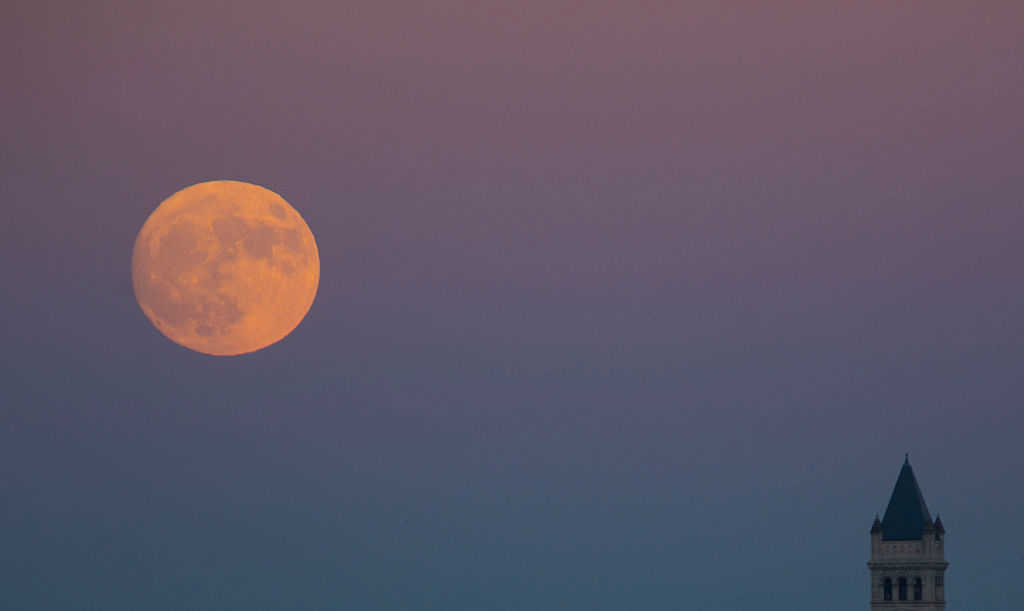The world was treated on Sunday night to the brightest “supermoon” we’ve seen in 70 years — a stunning display in the skies for those able to observe it.
And if you were wondering why the moon appeared so much bigger and brighter than normal, consider this: The moon hit it’s pedigree, the time in its orbit when it is closest to Earth. Since the moon’s path around Earth is more like a slight oval than it is circular there are times in which the moon is actually closer to our planet, the Los Angeles Times reported.
While supermoons themselves aren’t all that rare and occur around every 14 months, Sunday’s “extra super” moon was the closest full moon to Earth of any other supermoon since 1948. And if that’s not stunning enough, consider that people will have to wait nearly 20 years to see anything quite like it again, according to NASA.
“We won’t see another supermoon like this until 2034,” the space agency proclaimed on its website.
As it turns out, the moon can be up to 14 percent closer to Earth during at its pedigree (again, the point that it is closest to our planet) compared to its apogee (when the moon is furthest from Earth).
Below, see some of the stunning photos circulating on Twitter last night and this morning:
Taking #supermoon pics tonight? Share them w/ @NASAGoddardPix & more using the hashtag #NASAsupermoon or on @Flickr: https://t.co/9LLK0Ja91q pic.twitter.com/iEKRl57mlS
— NASA (@NASA) November 14, 2016
https://twitter.com/LoganStahI/status/798018727669174272
The supermoon still rose
@NASAGoddardPix #NASAsupermoon pic.twitter.com/ujB0J2Vtmp— Dr. Jen Golbeck 🇺🇦🏳️🌈 (@jengolbeck) November 14, 2016
November 13, #Supermoon. I took these beauties at just around sunset at 5pm. #NASASupermoon #Supermoon2016 #SuperDuperMoon pic.twitter.com/Kvuc3O8oM0
— Krystal (@KrystalSeech) November 14, 2016
Did you see the #SuperMoon ? @CBS12 @NASA @CBSNews @ShareALittleSun @PalmBeachesFL @LakeWorthPBC @LakeWorthCRA #LoveFL #NASA #nasasupermoon pic.twitter.com/SiAw7hAJBt
— Greg Angel (@NewsGuyGreg) November 14, 2016
@NASAGoddardPix #Supermoon rising above ridge and Little Colorado River north of Springerville, AZ #nasasupermoon Photography by @JillAdair pic.twitter.com/tZGNmz088y
— Jill Adair (@JillAdair) November 14, 2016
#supermoon crossing the SF-Oakland Bay Bridge on Sunday @NASA @NASA_es @NASAGoddardPix #NASAsupermoon #supermoon2016 https://t.co/PDlMcLyfvW pic.twitter.com/70950Q9Z0H
— Asier Ríos (@asierrios) November 14, 2016
Did you miss Sunday’s extra super supermoon? If so, no worries.
Noah Petro, deputy project scientist for NASA’s Lunar Reconnaissance Orbiter (LRO) mission, said in a statement on the NASA website that people still have a chance to catch the display on Monday evening as well.
“The difference in distance from one night to the next will be very subtle, so if it’s cloudy on Sunday, go out on Monday. Any time after sunset should be fine,” he said. “Since the moon is full, it’ll rise at nearly the same time as sunset, so I’d suggest that you head outside after sunset, or once it’s dark and the moon is a bit higher in the sky.”
—
Other Must-Read Stories:
– 14 Things That Will Uplift and Inspire You After America’s Brutal Presidential Election Battle
– Atheist Journalist-turned-Apologist Reveals What Shocked Him Into Becoming a Believer
– ‘A God Calling’: His Inspirational Quest to Help Wounded Military Veterans Is Having a Big Impact
– One of Donald Trump’s First Post-Election Acts: Comforting the Wife of a Murdered NYPD Cop
– GMA Host Has Post-Election Message for Christians: ‘We are Better Than That’



